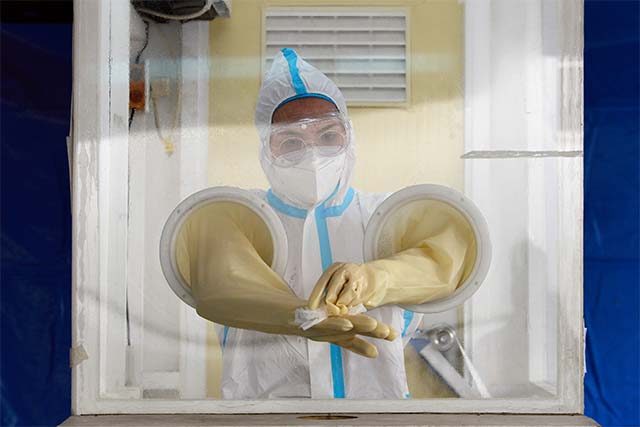
Filipinos urged the national government to consider the medical frontliners’ welfare after the Palace said that there is a possibility that the travel ban on countries with the new variant of the coronavirus disease will be lifted under a condition.
Presidential spokesperson Harry Roque on Thursday said the temporary travel ban for passengers from 27 countries could be lifted soon if the healthcare system is not overwhelmed by new patients infected during the holidays.
“So far hindi pa naman po natin nakikita iyong surge na galing po ng Pasko at Bagong Taon pero pinaghahandaan po natin iyan kaya nga nagkaroon tayo ng temporary travel ban hanggang January 15. ‘Pag lumabas na wala naman tayong surge dahil sa Pasko at Bagong Taon, eh handa naman po ang ating mga ospital para gamutin ang mga magkakasakit,” Roque said in an online briefing.
“Posible po na makapasok iyong mga dayuhan diyan. Now uulitin ko po ‘no, kakaunti lang naman iyang mga dayuhan na iyan dahil ang mga Pilipino’y pinapayagang umuwi. Ang mga dayuhan lang na pupuwedeng makapasok po ay iyong mga treaty traders at saka iyong mga visa holders ng mga economic zones ‘no; bawal pa rin po ang mga turista,” he added.
A treaty trader is a foreigner who seeks entry to the Philippines for the sole purpose of carrying on trade or commerce between the Philippines and the country of which he/she is a national.
As of Thursday, the country has temporarily imposes a travel ban on passengers coming from 27 countries such as the United Kingdom, United States, Hong Kong, Japan, Singapore, South Korea, Canada and Australia, among others.
The new COVID-19 variant, first detected in the United Kingdom, is said to be “up to 70% more transmissible” than the previously dominant one.
Meanwhile, some Filipinos criticized Roque for his remarks that foreigners from countries with the new variant might be allowed to enter the country if there is no surge of cases from people who have been infected during the holidays.
“So we’ll just wait until then? Have some compassion sa mga health workers. Why not take a preventive and proactive action? Nakakapagod na how this gov’t is taking this matter,” a Twitter user said in response to the news.
“Maawa naman kayo sa mga doctors natin ampota, akala niyo naman naglalaan kayo ng tamang budget sa healthcare,” wrote another online user.
“For real???? Maawa naman kayo sa mga frontliners, aanatyin niyo pa talaga na magkaron at kumalat ‘yung bagong variant,” a different Filipino likewise commented.
“Our frontliners are literally exhausted from treating patients 24/7 and (worse), can’t even go home to their families in fear of passing the virus to their loved ones—which (obviously), is taking a toll on their mental and physical health. Wtf are y’all trying to do?” another Twitter user said in response to the reports.
This week, Hong Kong reported it detected the COVID-19 new variant in a Filipino passenger who arrived from Manila on December 22.
Reports said that the 30-year-old passenger came from Cagayan Valley and underwent quarantine in Metro Manila on December 18. She tested negative a day after and was then allowed to leave for Hong Kong.
On Jan. 2, 2021, the passenger from the Philippines tested positive for COVID-19 new variant.
The Department of Health on Wednesday said that it is conducting contact tracing efforts on all fellow passengers of the infected passenger.
Meanwhile, the health agency and the Philippine Genome Center said that the new variant has not yet been detected in the country as of Wednesday.
An expert claimed the country’s cases could have a 15-fold increase in COVID-19 infections within just a month once the new COVID-19 variant reaches the Philippine shores.
“Normally, at our current Ro of 1.1, 20,000 cases at the beginning of the month will be about 32,000 cases by the end of the month,” Dr. John Wong, founder of the health research institution Epimetric, said in an interview.
“But if the variant takes over, the 20,000 cases can become almost 300,000 cases by the end of the month. This is what we want to avoid,” he added.
The government recently created the Technical Working Group on COVID-19 Variants tasked to “monitor and identify the occurrence of new variants of COVID-19 in the country” and to “provide policy recommendations to the IATF on the appropriate response.”
Health Undersecretary Maria Rosario Vergeire was assigned as its head while executive director Jaime Montoya of the Philippine Council for Health Research and Development was tapped as its co-chair.









